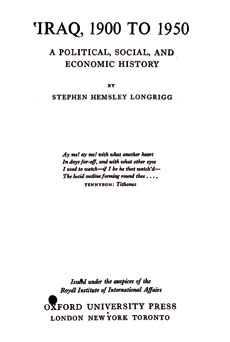| Éditeur : Oxford University Press | Date & Lieu : 1956, London |
| Préface : | Pages : 436 |
| Traduction : | ISBN : |
| Langue : Anglais | Format : 145x220 mm |
| Code FIKP : Liv. En. IKP Gén. 73 | Thème : Histoire |
|
Présentation
|
Table des Matières | Introduction | Identité | ||
 The 'Iraq of 1900 I. The Three Wilayas The tripartite territory was bounded on the north, amid wild mountains, by the Hakkari sanjaq of Van wilaya: on the north-west, by a short facie of the Jazira-ibn-`Umar qadhā of Diyarbakr wilaya: on the west, by the newly created 'independent' sanjaq of Dayr al-Zur. Farther south the boundary lay at the mid-desert frontier of the wilaya of Damascus and, south again, crossed the deserts of north Arabia, beyond which lay the Arab oasis principalities. To the south also lay the waters of the Persian Gulf and, along its western shores, a stretch of maritime Arabia which was claimed as Turkish and grouped officially under the Basra wilaya. To the east, bordering all three provinces, lay Persia. These boundaries were those of modern 'Iraq save in three particulars. The Persian frontier was still undemarcated; the line observed or flouted in 1900 was in places to be amended by the Commission of 1914. The boundary with the Turkish provinces of Van and Diyarbakr was to be fixed in 1926, that with later Syria in 192o and 1933, that with the Arabian rulers in 1922. The territories of al-Ahsā, Qatar, and Kuwayt ceased to be Turkish before or during the First World War, and do not concern the historian of 'Iraq. | |||||
| Table des Matières | ||||
Contents I. The 'Iraq of 1900 / I II. The last of Turkish 'Iraq / P. 41 III. War and british occupation / 75 IV. Mandate and monarchy / 99 V. The 'Iraq kingdom / 134 VI. To independence / 176 VII. Al-istiqlal al-tamm / 221 VIII. Prelude to war / 269 IX. The second world war / 298 X. End of the half-century / 334 Appendixes / 399 | ||||